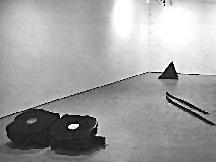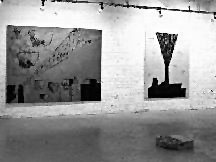- MAIN INDEX | ARTIST INDEX
| November 4 - 23, 1980 Six from the Styx
| |
 Six from the Styx, installation view, 1980. Photo Peter MacCallum. 18K |  Six from the Styx, John Clark, paintings, John Gill, sculpture, installation view , 1980. Photo Peter MacCallum. 18K |
| PRESS RELEASE Six artists affiliated with the Eye Level Gallery showing in Toronto in an exchange exhibition with Mercer Union. The six artists are:
Brad Brace - installation
Offerings From Maritimes Suffer Strange Power Failure
John Bentley Mays WHAT'S HAPPENING in the art scenes of Atlantic Canada? For the next while, Toronto gallery goers won't have to don their sou'westers and brave the coastal gales of autumn to get an answer to that question - since Atlantic Canadian art has come to Toronto packaged in two disconcerting shows. The first is the Eye Level Exchange, at Mercer Union (26 Mercer St.), continuing until Nov. 22. This group show is one end of a deal between Toronto's Mercer Union and the Eye Level Gallery in Halifax -- like Mercer Union, a non-profit exhibition centre run collectively by artists. In exchange for two Mercer artists (Robert Wiens and Peter Hill), the Eye Level people sent along six artists associated with their gallery, and a quite motley crowd they are. At least, they seem to be, when you first walk into the gallery: only a curious lack of energy appears to be keeping this quarrelsome, visually jarring display of work from breaking up into a general fracas. Or maybe it's that down-east guard-dog the Mercer curators have posted at the entrance of their gallery: Colette Urban's hound (the artists have nicknamed him Spot), a rather sinister, lifesize statue made of branches and twigs, worn feathers, scraps of fabric, all lashed together with twine and wire, and standing in a circle of plaited, dry grass. Beyond Spot, on the far wall, are three grey or brown, rather sullen constructions -- wrinkled paper, heavily over painted with rough grids or fabric patterns mounted on irregularly shaped pieces of plywood -- by Carol Wainio, which lead directly on to John Clark's big, brashly colourful oils about people, factories, etc. On the floor between Spot and the grumpy Wainio constructions is a squat, square block of concrete with a large chunk of undressed granite embedded in it, and, steel-strapped most of the way up a column nearby, a small boulder of salt and pepper granite -- caught, as it were, trying to escape through the roof hatch. Opposite these pieces by Dennis Gill -- at the far side of the gallery from the redoubtable Spot--appear three things by John Greer (a veteran of Toronto's Isaacs Gallery) a two-part work involving a black elastic band construction up in the corner and a grey granite sculpture that could fit exactly inside the elastics; cast iron skis; and another two parter, this time made by cutting a boulder of black African granite in two, polishing the cut faces and grinding out a cup-shaped depression in each face. Finally, there is reported to be -- I saw it, but it wasn't working or installed -- an electric fan by Brad Brace rigged up to ring Amazing Grace through a tiny loud speaker. What, if anything, do these pieces have common? Where, if anywhere, is a thread of artistic sensibility we might call Atlantic sensibility? The clue isn't going to be found in normal unity. The styles run the gamut from conceptual chic (the Greer geometrical meditations) to the funkiness of Miss Urban's dog or hanging skin-piece (paper treated and coloured to look like dried animal hide, with fur made of dressmaker's pins. True, there seems to be a general rejection of abstraction and a general preoccupation with the recognisable image in this show, from Spot to Clark's depictions of factories and shouting men, from Miss Wainio's Matisse - like fabric patternings to Brace's singing fan -- and even Cireer has given in, and created a strong image in his iron skis. But it would be hard to find, anywhere in the civilised world, a serious artist under 40 who hasn't come down with a case of image - fever: renewed interest in recognisable imagery, like the flu, is on the autumn wind this year, and outbreaks of the epidemic can be expected everywhere The things only are common to the works in the Eye Level show. The first resistance to the rigorous, idea-oriented, "international" (i.e., New York) conceptualist notions that pervades (or used to pervade) the powerful Nova Scotia College of Art and Design (NSCAD), where most of these artists study or teach, or once did. That artists in Halifax - especially artists well into mid-career such as Greer and Clark -- should be attempting to carve out for themselves a unique space is understandable. What's surprising is that it has taken so much get-up-and-go out of them all. That's the second thing common to the art-works: their lack of strength. To be sure, everything in this show has been competently crafted or painted. But, with few exceptions, the sculptures and paintings have been made without whole-hearted conviction - as though the artists had learned from slides or U.S. art magazines how their art-work was supposed to look, but didn't get straight the problems underlying the style. Take the big paintings of Clark, for example. When it comes to mimicking the New Image Painting which was so fashionable in New York a couple of seasons ago, Clark hasn't missed a trick. The works have been done in richly brushed oils (trick #1), rude but sensuously rich colours (2), purposely flat, naive, cartoon-like figures (3) which have been laid out flat on the surface (4) with no regard for traditional perspective (5). The results of this studio magic are like most of the work in this show: fashionable, and imitative of some good, sharply focused art recently done in New York, Chicago and elsewhere -- imitations that don't go one better, that fail to work through the artistic problems they address with fresh energy and new, credible intelligence.
| |